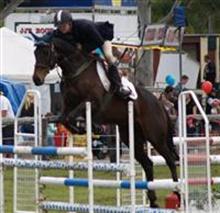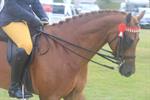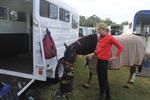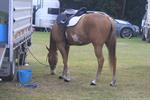 Learn About Horses:
Learn About Horses:
Learn to Manage the daily requirements of your horse
Learn about horse psychology and handling, evaluate conformation, understand the importance of dietary requirements to the horse, learn about the horses digestive system and the principles of feeding and watering your horse, use correct grooming procedures, develop appropriate management procedures and broaden existing knowledge of commercial opportunities in the horse world.
Manage horses kept on pasture and learn relevant pasture management techniques to maintain productivity and prevent "horse sick" pastures.
Lesson Structure
There are 7 lessons in this course:
- Psychology and Handling of Horses
- Buying A Horse
- Conformation
- The Equine Digestive System and Principles of Feeding and Watering
- The Grass Kept Horse and Pasture Management
- Equine Grooming
- Equine Industry Applications
Each lesson culminates in an assignment which is submitted to the school, marked by the school's tutors and returned to you with any relevant suggestions, comments, and if necessary, extra reading.
Aims
 Describe the procedures for the buying and selling of horses.
Describe the procedures for the buying and selling of horses.- Differentiate between the different procedures used for the handling of horses.
- Develop a program for the evaluation of the conformation of horses on a property/facility.
- Analyse the digestive system, including structure and function, of horses.
- Develop appropriate procedures to manage a horse at grass.
- Explain the methods used to prepare horses for specific uses, including their grooming for different tasks.
- Explain commercial opportunities available in the horse industry.
Start Your Equine Education Here
This course is designed as a foundation for either further studies or learning more about horses through experience (or both). It helps you understand both the physical and psychological attributes of different horses, how to properly handle animals, and what needs to be done to maintain their good health and conformation.
Conformation describes the shape of the horse. Things that influence conformation are:
Conformation, therefore, is very important in the study of horses. It in turn effects:
- The action (movement) of the horse
- The ride the horse gives
- The soundness of the horse (whether the horse is prone to lameness)
- The type of work the horse can perform
- The weight the horse can carry
Course Duration: 100 hours, nominal duration for the average student
General actions for safe and respectful handling
Using our understanding of horse psychology and normal behaviours, we can handle horses safely and with ease. Remember that the horse is gregarious. It will be easier to bring all the horses from a paddock rather than just one. Avoid making sudden noises or movements around horses. Build up the horse's trust in you by being calm and confident.
Handle horses:
- Calmly
- Confidently
- Patiently and slowly
- Talking quietly
Catching and Releasing
- Consider the use of appropriate safety clothing with sensible, sturdy footwear as a minimum. Gloves and a hard hat may be necessary if the horse is known to be difficult to handle
- Make the horse aware of your presence by talking calmly to him
- Approach the horses shoulder. Never approach directly in front of the horse; due to the anatomy of his head and the placement of his eyes, there is a blind spot directly in front of the horse’s nose. Approaching from the front may spook the horse and cause him to flee or kick out.
- Gently place the lead rope around the horse’s neck to stop him walking off
- Fit the head collar appropriately
- When releasing, ensure there is enough space to do so safely
- When releasing into a field, walk the horse some way into the field and then turn his head to face the gate or fence. When releasing in a stable, turn the horses head towards the stable door. This ensures that the handler is out of the way of the horses hind legs and reduces the likelihood of being kicked
- Standing beside the horses shoulder, place the lead rope over the around the horse’s neck to prevent them walking off. Hold firmly in your right hand. Unbuckle the headcollar with the left hand and remove it gently. Release the hold the lead rope when the horse is standing still and you are ready. Step back.
Leading
- Fit the horse with a head collar or bridle if more control is needed with an exuberant horse
- Ensure the proposed route is free from hazards
- Lead from the left or ‘near’ side of the horse, positioned beside the horses shoulder
- Hold the lead rope with the right hand under the horses chin and the excess rope in your left hand
- Never wrap the rope around your hand; should the horse spook and flee, you could be dragged and badly injured
- Ask the horse to ‘walk on’ and maintain position beside its shoulder
- If the horse is reluctant to move, a sharp tap with a whip behind the near shoulder should encourage him
- Never ‘drag’ the horse along or position yourself directly in front of him
- When turning around, always turn the horses head away from you – this reduces the likelihood of the handler being stood on and injured
- Remember to leave sufficient space when leading through gates and doorways to ensure that the horse does not catch and injure itself
Tying up
- Horses should always be tied to a piece of breakable string attached to a fixed tie ring set into a solid structure. They should never be tied to gates or other movable objects
- Ensure the tying up area is clear and free from hazards
- Catch the horse and fit an appropriate head collar
- Lead the horse to the tie up area
- Tie up to a piece of breakable string using a quick release knot
- Ensure that the horse is tied up with an appropriate length of lead rope; an excessively short lead may be uncomfortable for the horse and an excessively long lead is at risk of causing an accident if the horse should get his foot or leg tangled in it
Working around the Horse
- Always talk quietly to the horse to make it aware of your presence
- Ensure the horse is secured with a head collar and rope when you are working around it and that there are no obvious hazards in the area
- Do not make any loud noises or quick movements that may startle the horse
- When moving from one side of the horse to the other go around the front of the horse under his head
- If for some reason you have to move around the back end of the horse, make sure he is aware of where you are and what you are doing by talking to him and patting him on the rump
Bridling
- Collect the horses bridle
- Secure the horse with a head collar and lead rope
- Ensure the horse is groomed and the head is clean and free from dirt and dust
- Prepare the bridle by undoing the throat lash and nose band
- Approach the horse’s nearside. Undo the lead rope and pass it around the horses neck
- Slip off the head collar and pass the reins of the bridle over the horses neck
- You can either pass your right hand underneath the horses head and hold the bridle by the cheek pieces just under the level of the brow band OR hold the headpiece with your right hand in front of the forehead with the bit cupped in left hand.
- Cup the bit in your left hand
- Raise the bridle with your right hand and slip the bit into the horse’s mouth, supporting it with your left hand. Do this gently.
- Place the bridle over the horses head, slip the ears under the headpiece and straighten the horses forelock over the brow band.
- Do up the throat lash and nose band and ensure the bridle is straight and looks comfortable (slight suggestion of a wrinkle at the corner of the mouth).
- Replace the head collar and retie the horse. Please note this is acceptable if saddling up in a box or a stall. It is not recommended outside as the person has no control over the horse. When outside, if it pulls away for whatever reason, the horse, saddle, bridle, head collar and lead rope will part company with handler. Therefore when bridling outside, forget about using the lead rope and have your right arm through the reins (not tangled or knotted in any way for your safety) if joined reins, or hold near side rein if split reins.
 Saddling
Saddling
- Collect the horse’s saddle, girth and saddle pad/saddle cloth (numnah). Ensure the stirrups are run up on the saddle so that they do not bang the horse’s ribs, back or withers region when lifting the saddle over the horses back. Place all tack carefully near where you’re working with the horse but keep it in a place where it does not block access or cause a problem for the horse if it moves.
- Secure the horse with a head collar and lead rope
- Ensure the horse is groomed and the saddle and girth area is clean and free from dirt and dust
- Standing on the near side of the horse, place the saddle pad and saddle on the horses back, slightly further forward up the horse’s withers and then slide it back into place to ensure the horses coat lies flat. Pull the saddle cloth upwards, so that it sits in the gullet of the saddle rather than tight across the horses spine
- Move to the offside of the horse by passing under the horse’s neck and adjust and straighten the girth on the offside.
- Return to the near side and secure the girth. Leave it slightly loose to accustom the horse to the feel of it. Remember to fully tighten before mounting
Summary of Safety Rules When Handling Horses
- Always alert the horse to your presence-speak quietly and softly
- Approach from the side of the horse
- Stand at the horse's shoulder
- Never stand directly in front of the horse
- Never stand directly behind the horse
- Don't make loud noises or sudden movements around the horse
- Never tie the horse to a loose or unstable object
- Never feed a group of horses treats in a paddock. They become jealous over food and could start kicking and biting
- Anticipate trouble - look ahead
- Handle horses firmly, kindly and with confidence